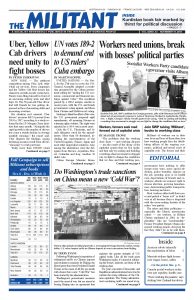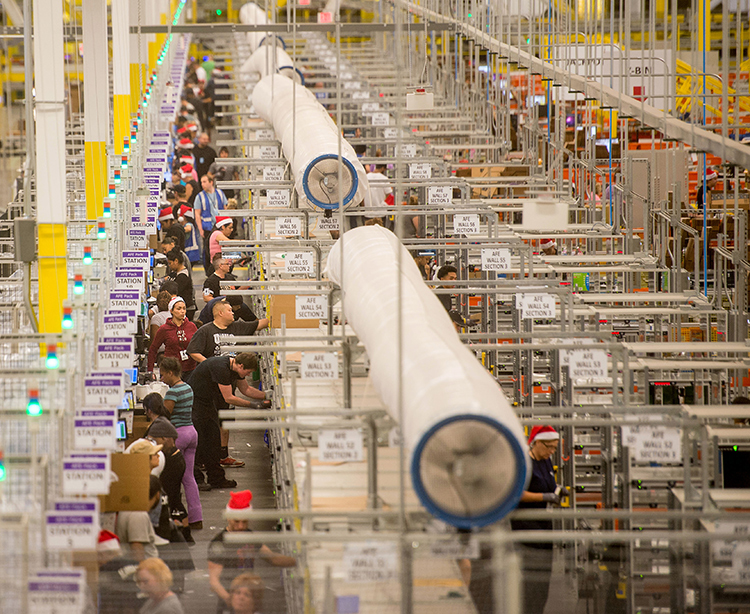Amazon is the second-largest employer in the U.S. after Walmart and one of only two U.S. companies ever valued at over $1 trillion. It operates huge fulfillment warehouses where workers face relentless speedup and unsafe conditions amid miles of conveyor belts, computer-set workloads and thousands of robots, all pushing them to work harder.
“Amazon’s one-million-square foot distribution center in Baltimore is a massive fulfillment machine,” Christopher Mims wrote in a gushing Oct. 15 Wall Street Journal article titled “How Robots and Drones Will Change Retail Forever.” The warehouse has “a dazzling combination of chutes, ladders, rollers and 11 miles’ worth of conveyor belts.”
“Humans are rarely required to move around here,” Mims claims. “It’s much faster, and cheaper, to have stuff brought to them.”
“Resembling oversize Roombas topped with Ikea shelving,” Mims writes, 8-foot-tall robots scurry around carrying up to 750 pounds of goods in their 40-odd yellow cubbies. But while they can haul the goods, these robots can’t grasp them like a human hand can do and fill the order. Robots also can’t load or unload trucks. So while the mesmerized Journal scribe writes as though there are only a handful of workers there, in fact there are over 3,000.
As increasing numbers of companies began using these Kiva robots, Amazon in 2012 bought up Kiva for $775 million and took the machines off the market. Amazon bosses then made them the backbone of their distribution centers.
Today Amazon has some 100,000 robots hurtling about its over 140 fulfillment centers worldwide — about 75 of them in the U.S.
The heart of Mim’s article is the idea that in a few short years there won’t be any workers, and Amazon’s warehouses will be 100 percent automated. And so will their delivery system — with a fleet of driverless vans, pilotless blimps and drones for final drop-off. “Imagine a drone dropping out of the sky to deliver you an iced coffee on your walk to work,” he says. “In fact, IBM already has a patent for that.”
Bosses in China recently announced plans to open a factory where robots will make robots for use in factories there and for export in Asia.
Frederick Engels, one of the founders of the socialist and modern working-class movement, wrote about this 150 years ago. The capitalists are “periodically seized by fits of giddiness in which they try to accomplish the money-making without the mediation of the production process,” he wrote.
Hiring by the tens of thousands
But the fact is Amazon has been increasing its hiring while putting more robots on the warehouse floors. The company employs 575,000 people, an increase of 235,000 from just one year ago. Facing a labor shortage, Amazon bosses raised the minimum wage for workers in the U.S. to $15 an hour. A few days later they announced they would cut their losses by eliminating bonuses and stock options.
These moves follow strike actions over low pay and speedup by workers in Amazon warehouses in Europe this summer. A one-day strike was organized at six facilities in Germany July 17. Workers in Spain went out for three days then, and in Poland workers staged a “work-to-rule.”
Amazon is owned by the world’s richest person — Jeff Bezos, a Silicon Valley type who also owns the Washington Post, has $112 million in Airbnb, a hunk of Uber and his own rocket ship company.
There is an explosion in retail warehousing by Amazon, Walmart and other companies seeking to crush their competition. Amazon is opening its fourth fulfillment center in Maryland this month on the site of the former Sparrows Point U.S. Steel mill in Baltimore. This site and adjacent shipyard were bought up by investment capitalists organized as Tradepoint Atlantic.
They’ve already got contracts for warehouses and other operations from Under Armour, FedEx and Harley-Davidson, as well as Amazon. Governments at the city, state and national level have handed out tens of millions of dollars to the bosses to operate there.
Amazon says the new facility will stock 20 million products, employ 1,500 workers and ship 1 million orders every day. FedEx bosses say their 425 workers in Sparrows Point will process some 15,000 packages hourly.
While the bosses — and politicians in both of the bosses’ parties who throw money at Amazon — are all agog, it isn’t the same for the workers. Indeed.com, an internet site that “helps” hiring by running ratings on what it’s like to work for various bosses by current and former employees, has been keeping score on Amazon’s warehouses.
Entries include: “they work you like slaves,” “management is evil,” “the surveillance is jail-like,” “management is just bad all the time,” and vivid descriptions of speedup and 12-hour days. One entry headed “highway to hell” says, “If you ever wanted to sell your soul to the devil but didn’t know how, this is a close second. Every horror story you’ve probably heard about working here I can confirm is true.”
One former fulfillment workers sums it up, “Low pay, on your feet all day, unrealistic work demands, work is repetitive, short breaks, no union.”
And that is what they need — a union.


